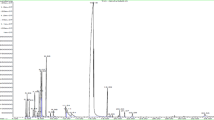Abstract
The hydrodistilled volatile oil obtained from aerial parts of Cleome oxypetala Boiss. was analyzed by gas chromatography and mass spectrometry (GC–MS). Fifteen compounds were identified, representing 99.27% of the total oil composition, with Sandaracopimaradien-3β-ol (71.9%) being the main component. Oil antimicrobial activity was carried out using the minimal inhibitory concentration (MIC). The best antibacterial activity was observed against Escherichia coli with MIC value of 32 μg/mL. Also, this oil showed good DPPH radical-scavenging activities (IC50: 7.3 ± 0.4 mg/mL).


Similar content being viewed by others
References
Adams RP (2007) Identification of essential oil components by gas chromatography/mass spectrometry, 4th edn. Allured, Carol Stream
Ahmad VU, Alvi KA (1986) Deacetoxybrachycarpone, a trinortriterpenoid from Cleome brachycarpa. Phytochemistry 26(1):315–316
Ahmad VU, Qazi S, Zia NB, Xu C, Clardy J (1990) Cleocarpone, a triterpenoid from Cleome brachycarpa. Phytochemistry 29(2):670–672
Bose A, Gupta JK, Dash GK, Ghosh T, Si S, Panda DS (2007) Diuretic and antibacterial activity of aqueous extract of Cleome rutidosperma D.C. Indian J Pharm Sci 69(2):292–294
Devi BP, Boominathan R, Mandal SC (2003a) Evaluation of antipyretic potential of Cleome viscosa Linn (Capparidaceae) extract in rats. J Ethnopharmacol 87(1):11–13
Devi BP, Boominathan R, Mandal SC (2003b) Studies on analgesic activity of Cleome viscosa in mice. Fitoterapia 74(3):262–266
Dhar ML, Dhar MM, Dhawan BN, Mehrotra BN, Ray C (1968) Screening of Indian plants for biological activity: I. Indian J Exp Biol 6(4):232–247
EL-Ansari MA, Barron D, Abdalla MF, Saleh NAM, Le Quere JL (1991) Flavonoid constituents of Stachys aegyptica. Phytochemistry 30(4):1169–1173
Farjam MH, Khalili M, Rustayian A, Javidnia K, Izadi S (2011) Biological activity of the n-butanolic extract of Stachys pilifera. Afr J Microbiol Res 5(28):5115–5119
Fushiya S, Kishi Y, Hattori K, Batkhuu J, Takano F, Singab AN, Okuyama T (1999) Flavonoids from Cleome droserifolia suppress NO production in activated macrophages in vitro. Planta Med 65(5):404–407
Gul HI, Ojanen T, Hanninen O (2002) Antifungal evaluation of bis Mannich bases derived from Acetophenones and their corresponding piperidinols and stability studies. Biol Pharm Bull 25(10):1307–1310
Hashem FA, Wahba HE (2000) Isothiocyanates in myrosinase treated herb extract of Cleome chrysantha Decne. and their antimicrobial activities. Phytother Res 14(4):284–287
Hussain J, Rehman UN, Al-Harrasi A, Ali A, Latif Khan A, Albroumi MA (2013) Essential oil composition and nutrient analysis of selected medicinal plants in Sultanate of Oman. Asian Pac J Tr Dis 3(6):421–428
Hwang BY, Kim HS, Lee JH, Hong YS, Ro JS, Lee KS, Lee JJ (2001) Antioxidant benzoylated flavan-3-ol glycoside from Celastrus orbiculatus. J Nat Prod 64(1):82–84
Liu X, Dong M, Chen X, Jiang M, Lv X, Yan G (2007) Antioxidant activity and phenolics of an endophytic Xylaria sp. from Gingko biloba. Food Chem 105(2):548–554
Meremeti A, Karioti A, Skaltsa H, Heilmann J, Sticher O (2004) Secondary metabolites from Stachys ionica. Biochem Syst Ecol 32(2):139–151
Miyase T, Yamamoto R, Ueno A (1996) Phenylethanoid glycosides from Stachys officinalis. Phytochemistry 43(2):475–479
Nishimura H, Sasaki H, Inagaki N, Chin M, Mitsuhashi H (1991) Nine phenethyl alcohol glycosides from Stachys sieboldii. Phytochemistry 30(3):965–969
Raghavan RS (1993) Capparaceae. In: Sharma BD, Balakrishnan NP (eds) Flora of India, vol 2. Botanical Survey of India, Howrah, pp 248–335
Sarker AK, Ahamed K, Chowdhury JU, Begum J (2009) Characterization of an expectorant herbal basak tea prepared with Adhatoda vasica leaves. Bangladesh J Sci Ind Res 44(2):211–214
Scalbert A, Manach C, Morand C, Remesy C (2005) Dietary polyphenols and the prevention of diseases. Crit Rev Food Sci Nutr 45(4):287–306
Selloum L, Arrar L, Medani B, Khenchouche A, Bisker H (1995) Effect of Cleome arabica leaves extract on inflammatory cells response in rat. Biochem Soc Trans 23(4):609s
Selloum L, Sebihi L, Mekhalfia A, Mahdadi R, Senator A (1997) Antioxidant activity of Cleome arabica leaves extract. Biochem Soc Trans 25:608
Sharaf M, Mansour Ragaa MA, Saleh Nabiel AM (1992) Exudate flavonoids from aerial parts of four Cleome species. Biochem Syst Ecol 20(5):443–448
Sharaf M, El-Ansari AM, Saleh Nabiel AM (1997) Flavonoids of four Cleome and three Capparis species. Biochem Syst Ecol 25(2):161–166
Simoes C, De Mattos JCP, Sabino KCC, Caldeira-de-Araujo A, Coelho MGP, Albarello N, Figueiredo SFL (2006) Medicinal potential from in vivo and acclimatized plants of Cleome rosea. Fitoterapia 77(2):94–99
Sudhakar M, Rao ChV, Rao PM, Raju DB (2006) Evaluation of antimicrobial activity of Cleome viscosa and Gmelina asiatica. Fitoterapia 77(1):47–49
Tsichritzis F, Abdel-Mogib M, Jakupovic J (1993) Dammarane triterpenes from Cleome Africana. Phytochemistry 33(2):423–425
Verzelloni E, Tagliazucchi D, Conte A (2007) Relationship between the antioxidant properties and the phenolic and flavonoid content in traditional balsam vinegar. Food Chem 105(2):564–571
Vundac VB, Brantner AH, Plazibat M (2007) Content of polyphenolic constituents and antioxidant activity of some Stachys taxa. Food Chem 104(3):1277–1281
Yaniv Z, Dafni A, Friedman J, Palevitch D (1987) Plants used for the treatment of diabetes in Israel. J Ethnopharmacol 19(2):145–151
Zinchenko TV, Voitenko GN, Lipkan GN (1981) Anti-inflammatory, antitoxic, and hypoazotemic effect of a Stachys recta preparation, stachyrene. Farmakol Toksikolog 44:191–194
Acknowledgements
Financial support from the Research Council of Ahvaz Branch of Islamic Azad University (Grant no: 51061921101002) is gratefully acknowledged.
Author information
Authors and Affiliations
Corresponding author
Rights and permissions
About this article
Cite this article
Doulah, A., Farjam, M.H., Salehzadeh, A. et al. Phytochemical and Biological Evaluation of Essential Oils of Cleome oxypetala Boiss. From Iran. Iran J Sci Technol Trans Sci 41, 1093–1098 (2017). https://doi.org/10.1007/s40995-017-0276-z
Received:
Accepted:
Published:
Issue Date:
DOI: https://doi.org/10.1007/s40995-017-0276-z




